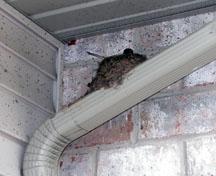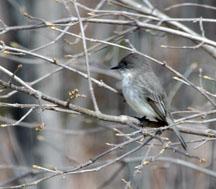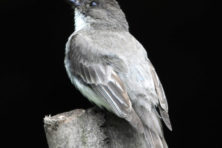The Eastern Phoebe
- Share
- Tweet
- Pin
- Share
There are few birds whose spring arrival we more eagerly anticipate than the Eastern Phoebe. They can live upwards of nine years and frequently return to the same nesting site in successive years. To us, they belong here, they’re part of the family. We’ve kept many bird sighting records over the past 38 years, and recorded arrivals as early as late March in an unusually warm spring, but their arrival here is more likely to occur around April 10.
These seven-inch flycatchers have become a daily part of our early summer lives in such subtle but predictable ways, and obviously that’s why we admire them so much. I’ve built three very simple, 12” X 12” X 12”, three-sided nesting shelves, each having a bottom, back and one side. I make sure that the one side is on the west side of the unit so that it’ll provide the female and nestlings protection from the more prevalent prevailing westerly winds. Our south garage roof and the roof on the north side of our home both are around nine feet above the ground. Both of the shelves are fastened very close to the soffit, which in turn gives the shelves around two feet of roof-overhang and excellent protection from the weather.
Last year the pair nested successfully on the south side of the garage, and this year they used the north side of the house for raising their brood of four young. Sitting on a chair next to the window in our bathroom affords us wonderful looks at the Phoebes hunting for insects, always using one of several favorite hunting perches including the stair railing posts and nearby branches. A few weeks ago I pushed a six-foot dead branch into the ground so it stood upright, around a dozen feet from the bathroom window, and within minutes the phoebes had found it and were using it as another hunting perch. It also provided me with a perfect vantage point for photographing the skilled aerialists.
Because of the Eastern Phoebe’s ability to survive on aquatic winter insects floating on the water, and also berries and seeds, they winter farther north than the other flycatchers that nest in our woods or nearby. Included are the Eastern Kingbird, Great-crested Flycatcher and the Eastern Wood Pewee which usually winter in Central America or farther south. One of the most unusual finds on any of our past Christmas Bird Counts was an Eastern Phoebe seen on Dec. 15, 1984 along Anclam Road south of the Baileys Harbor Yacht Club. That December was extremely mild and the bay and harbors were completely free of ice.
About 53 years ago, in May of 1957, I was scouting several potential outdoor sites at Wyalusing State Park to visit on a three-day camping and bird-study field trip with my sixth grade bird club from the Shorewood Elementary School in Madison. A beautiful trickle of a waterfall coming over a fairly high stone cliff at the end of a fascinating rock canyon was a “must” on our itinerary. What a stroke of luck it was for us to find an Eastern Phoebe nesting on a narrow ledge along the rock wall.
Fortunately the wall sloped inward giving the nest ample protection from rains, and the nest was low enough to provide us with excellent binocular views of the Phoebe pair. So fond was I of this pristine Phoebe “canyon” that I took Charlotte to see it 15 years later during our honeymoon in May of 1972, and yes, the Phoebes were using that very same shelf again that spring.
The Phoebe’s nest is composed largely of mosses, fine grasses and a small amount of mud. The nest I collected from their last year’s nesting shelf is rather bulky but quite firm, beautifully constructed and amazingly light. On many occasions we watched our Phoebes gather the mud from the wet ground next to our birdbaths. I purposely muddy up the soil next to the two garbage-can lids, placed upon the ground, which I scrub out every morning before refilling them, and it is there that the Phoebes and also Robins come for their nest mud.
One of our most favorite sightings of the Phoebe is while it is bathing. Rather than hopping into the middle of one of the shallow containers of water on the ground and splashing around like the Robins and most of the other bird do, this bird flies through the water. Sometimes is will flutter through the water from one lip of the lid to the other, repeating this several times before flying to a nearby perch to shake off the water, preen and rearrange its feathers.
At other times the bird will fly from a three-foot-high perch next to the baths directly through the water and right up to its preening branch. Charlotte says that it’s a flycatcher and also a fly-bather. We’ve seen the Eastern Kingbird and Great-crested Flycatcher bathe in this manner and we strongly suspect that other flycatchers do so as well. The next time you refresh yourself with a dip in the pool or lake, think about the birds and how much they too would like to do the same. Birdwatching in your yard will improve greatly when you provide the birds with water.
On many occasions, while touring with visitors in the woods or during bird hikes, I’ve asked the people to identify the hidden bird singing the high, sweet, drawn-out and musical “FEEE-be-be.” Invariably the answer is, a Phoebe. If only a real Phoebe could also be singing nearby, they would clearly hear the difference. They are actually hearing a Black-capped Chickadee. The Eastern Phoebe’s two-syllable song is a rather abrupt, explosive and wheezy “WHE-be” compared to the musical and more drawn-out chickadee’s “FEEE-be-be,” a three syllable song.
All in all the Phoebes are easy and delightful birds to have around. Not only do they not have to be fed by people, but they are members of that invaluable force of natural, safe and free insect population controllers. Provide them with nesting shelves, water and mud and all the help and protection they so richly deserve.





